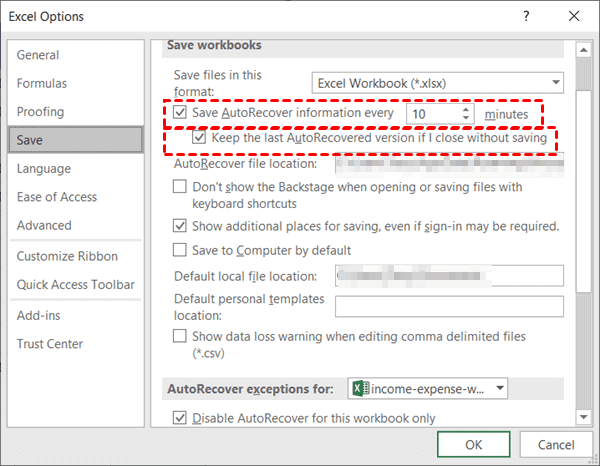5 Ways to Recover Your Autosaved Excel Sheet

Losing unsaved work in Excel can be a distressing experience, especially if you have spent hours or even minutes on a project. However, Excel has built-in recovery options and strategies that can often retrieve your work. Here's how you can recover your autosaved Excel sheet and minimize future loss.
1. Understanding AutoRecovery

Microsoft Excel features an AutoRecovery function designed to save your work periodically. Knowing how this works can help you recover lost data:
- Excel autosaves your work at intervals set within the application.
- To access these files, navigate to File > Options > Save and look at the settings for AutoRecover information.
Steps to Recover an Autosaved File:

- Open Excel.
- Go to File > Info > Manage Workbook > Recover Unsaved Workbooks.
- Here, you’ll see a list of autosaved files from the last session.
💡 Note: AutoRecover files are temporary and are cleared on system reboot.

2. Using the Document Recovery Pane

When Excel crashes or closes unexpectedly, it often shows the Document Recovery pane upon reopening:
- Look for a pane labeled “Document Recovery” on startup.
- Select the file you want to recover from the list.
- Choose options like Open or Save As to keep the recovered data.
How to Access Document Recovery:

- Open Excel.
- Click on File > Info.
- If recovery is available, you’ll see an option to manage documents.
👀 Note: Document Recovery is not always visible; ensure AutoRecover is enabled.
3. Searching for .xlsb Files

If AutoRecover does not help, look for Excel’s backup files:
- Excel often saves backup files with the extension .xlsb.
- Search your drive for *.xlsb files in locations like C:\Users[Username]\AppData\Roaming\Microsoft\Excel.
Locating .xlsb Files:

- Open File Explorer.
- Type *.xlsb in the search bar.
- Filter by File Type if needed to find backup files.
📂 Note: Backup files can be in various hidden system folders.
4. Check Temporary Files

Windows keeps temporary files that can include your unsaved Excel work:
- Press Win + R to open Run command.
- Type %temp% and hit Enter to access the temp folder.
- Look for files with Excel-related extensions.
Finding Temporary Excel Files:

- Open the Run dialog.
- Use %temp% to locate the temporary files.
- Sort by date modified to find recently created files.
📌 Note: Temporary files are frequently cleared by the system.
5. File History or Backups

Use File History or backups for recovery:
- Windows 10’s File History can help restore previous versions of files.
- If you back up regularly, check your backup drive for older copies of your workbook.
Restoring with File History:

- Right-click your Excel file.
- Select Properties > Previous Versions.
- Select a version to restore.
⏮️ Note: File History is not enabled by default and must be configured.
In this guide, we’ve covered five effective ways to recover your autosaved Excel sheets. Understanding Excel’s recovery mechanisms, utilizing the Document Recovery pane, searching for .xlsb backup files, exploring temporary folders, and leveraging File History or backups can be your go-to methods for retrieving lost work. By setting AutoRecover to save frequently, creating your own backup strategies, and understanding where to look for lost files, you can minimize the impact of losing unsaved work in the future.
How often does Excel AutoRecover?

+
The default AutoRecover interval in Excel is 10 minutes, but you can adjust this to save more frequently.
Can I recover an Excel file after a system crash?

+
Yes, the Document Recovery pane often appears when Excel restarts after a crash, allowing recovery of unsaved work.
What if AutoRecover doesn’t have my file?

+
If AutoRecover doesn’t have your file, search for .xlsb files or check Windows’ temporary files for recovery options.
Do Excel backups save all my changes?

+
Backups typically save the last state of the file. Enable frequent AutoRecover to increase the likelihood of capturing recent changes.